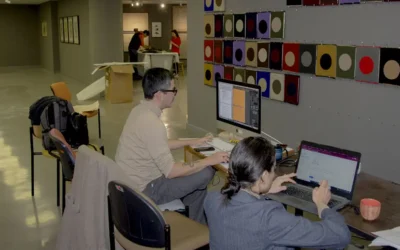Considering Museum Digitization Tools by Item Type

Rachael Cristine Woody
There is a vast array of museum item types found among our museum collections. While we tend to focus on 3D objects as our primary display items, the truth is that historical, cultural, and artistic items can be found in bound volumes, 2D items (documents and photographs), and audio-visual media.
However, with increasing focus on digitization and the ability to mix collection types within a Collections Management System (CMS), there is an increasing focus on non-object, complementary material. When thinking about upcoming museum digitization projects it’s likely that the tools you need will span several item types—and more than one digitization tool will be needed. This post will offer an overview of common digitization tools (both hardware and software) per museum item type.
Digitization of Objects
In a museum setting, 3D objects are likely the majority item-type and if you’ve worked with digitization projects before you are already familiar with the still image photography as the default tool of choice when capturing a digital surrogate of a 3D item. However, a camera and its output products can also be used in photogrammetry and Reflectance Transformation Imaging (RTI). I’ve reviewed these and the LIDAR methodologies previously and you can read more about them here, here, and here.
Digitization of Objects Equipment
- Camera
- Still image
- Photogrammetry
- Reflectance Transformation Imaging (RTI)
- Laser
- Light Detection and Ranging (LIDAR)
Digitization of Objects Software
- Still image
- Any software of choice; ex: Adobe Photoshop
- Photogrammetry
- Structure from Motion (SfM) method; ex: Agisoft Metashape
- Reflectance Transformation Imaging (RTI)
- Polynomial Texture Mapping (PTM) method and open-source software
- Light Detection and Ranging (LIDAR)
- Grass GIS (open-source)
Learn more about photogrammetry and RTI methods via Cultural Heritage Imaging: http://culturalheritageimaging.org/.
Digitization Bound Items
Bound volumes can be a bit tricky due to their structure, potential fragility, their bulk, and (for more contemporary pieces) their copyright. It is both their structure (tightly bound, often large, and hundreds to thousands of pages) and fragility (red rot, cracked spines, loose pages, thin and/or brittle paper) that make them physically difficult to handle and scan. With this in mind, many museums opt for overhead scanners paired with book cradles, and a human (or mechanical) arm to gently turn the pages.
Digitization of Bound Items Equipment
- Overhead Scanner
- CZUR ET16 or 18 Plus
- Zeutschel Imaging Products
Digital of Bound Items Software
- Software that comes with the scanner
- Ex: Software that can account for bound volume curvature of pages and removing fingers or finger cots (to hold pages in place)
- Adobe and other image manipulation software
Digitization of Flat and Reflective Items
Second to digitizing 3D objects in a museum is typically the digitization of documents and photographs. A flatbed scanner is the preferred digitization tool for documents, photographs, slides, and negatives. If you’re considering a scanner purchase and you intend to digitization slides and negatives then acquiring a scanner with fitted trays to hold these items and perform “reflective” imaging is a must. Copy stand photography is another digitization tool that tends to work best for oversized or particularly fragile documents as it can be slow to setup and harder to capture and accurate image.
Digitization of Flat and Reflective Items Equipment
- Flatbed scanner with fitted slide and negative trays
- Copy-Stand photography
Digitization of Flat and Reflective Items Software
- Scanner software
- Computer-loaded or default imaging software; ex: Image Capture
- SaaS; ex: Adobe (or similar)
Digitization of Audio-Visual Materials
Audio and/or visual materials can be some of the most challenging material to digitize because there are so many formats that emerged during the 19th and 20th centuries. Additionally, some of the formats used to capture these materials have degraded fairly quickly due to the chemical processing required. As a result, many of these items are in danger of being lost and sometimes the only way to ensure preservation of the content is to digitize it.
Digitization of Audio and Video Equipment
- Vinyl record player, tape cassette player, etc.
- USB audio converter
Video Equipment:
- Film projector, VHS, and similar “tape” media
- USB video converter
Digitization of Audio Video Software
Example of Audio Software:
- Audacity
Example of Video Software:
- Video Capture
Conclusion
In most cases, the item format, size, and fragility will dictate which type of digitization equipment is needed. If your museum is in the market for acquiring more digitization tools, make sure to perform an assessment on what types of items you have and therefore, what digitization tools you need. Ultimately the goal is to find a tool or tools to help you get the job done right and fit your budget.

Rachael Cristine Woody
Expert Rachael Cristine Woody advises on museum strategies, collections management, and grant writing for a wide variety of clients. In addition to several titles published by Lucidea Press, Ms. Woody is a regular contributor to the Think Clearly blog and a popular presenter. Register here for her upcoming webinar, “How to Choose the Right Tools for Museum Digital Projects” on September 29, 2021. And learn about Lucidea’s Argus solution for powerful and innovative museum collections management.
Similar Posts
How to Incorporate Interns in Museum CMS Projects: Data Creation
A museum expert details how interns can be successfully included in museum CMS projects at the data creation stage.
How to Incorporate Interns in Museum CMS Projects: Data Capture
A museum expert highlights how interns can be included in museum CMS projects at the data capture stage
How to Incorporate Interns in Museum CMS Projects
A museum expert highlights how interns can be included in museum CMS projects with three project ideas.
Create a Start-to-Finish Process for Cataloging Objects in the Museum CMS
A museum expert outlines the start-to-finish process for cataloging objects into a new museum CMS.
Hosting service
Enjoy all of the benefits of your Lucidea solution with secure, reliable, stress free hosting
Programs & incentives
No matter your size or budget, we’ve got you covered, today and tomorrow




Leave a Comment
Comments are reviewed and must adhere to our comments policy.
0 Comments